THE SINGERS TOOLKIT
An Incomplete Guide for Baffled Choral Singers
Tempo (Fast or Slow)
Italian words are often used to indicate how fast or slow a piece should go (its TEMPO). They are relative and have no absolute value. This allows for much discussion and argument amongst musicians.

 The indications below appear to be absolute but are often varied according to how many performers are present and the amount of echo (acoustic):
The indications below appear to be absolute but are often varied according to how many performers are present and the amount of echo (acoustic):
 They mean (respectively):
They mean (respectively):
100 crotchet beats in a minute.
Here is a clip:
72 minim beats in a minute, and here is a clip:
You will notice that having minims as the main beat can make the crotchets rather fast.
50 semiquaver beats in a minute - with a clip
Counting in semiquavers makes things very slow..
You can hear what a difference these tempo indications make, as the three examples above are all written like this:

Return to:
TOP
MENU PAGE of Singers Toolkit
MENU PAGE of Organists Online
Volume (Loud or Quiet) [Dynamics]
These are the signs indicating LOUDNESS (volume). The are not absolute but RELATIVE, so there's lots of opportunity for discussion.
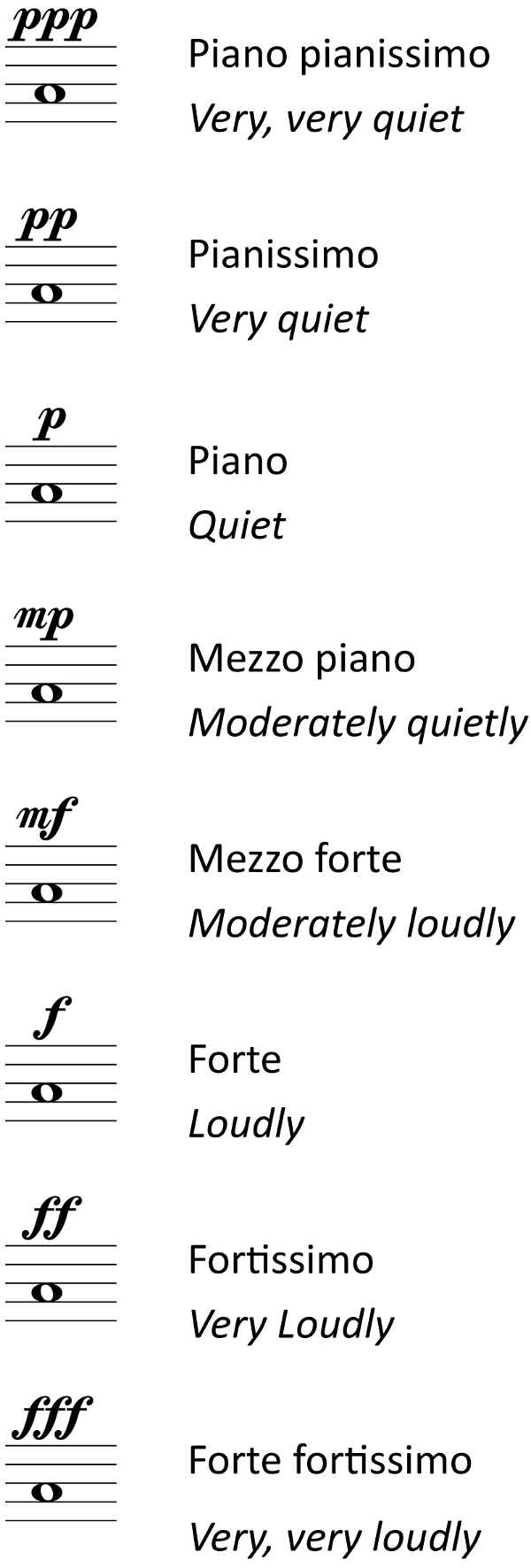 There is a tendency for choirs to under-sing the dynamic range. That is, the quiet sections are too loud and the loud sections are too quiet. To sing with a good dynamic range requires concentration.
Everything becomes a hum-drum mezzo.
There is a tendency for choirs to under-sing the dynamic range. That is, the quiet sections are too loud and the loud sections are too quiet. To sing with a good dynamic range requires concentration.
Everything becomes a hum-drum mezzo.
Usually, these signs are used for a whole section of a piece, or at least a bar or two.
These signs are use to emphasise or ACCENT a single note:
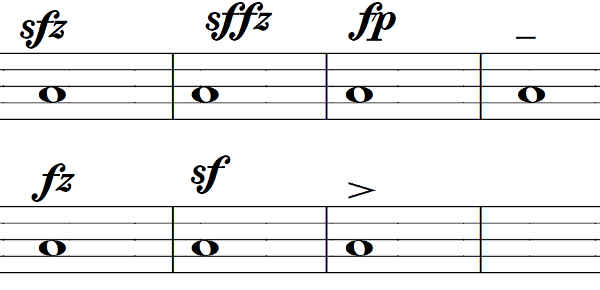 There are no signs or symbols for suddenly making a note much quieter.
It's possible to indicate whether the music should gradually get louder or softer:
There are no signs or symbols for suddenly making a note much quieter.
It's possible to indicate whether the music should gradually get louder or softer:
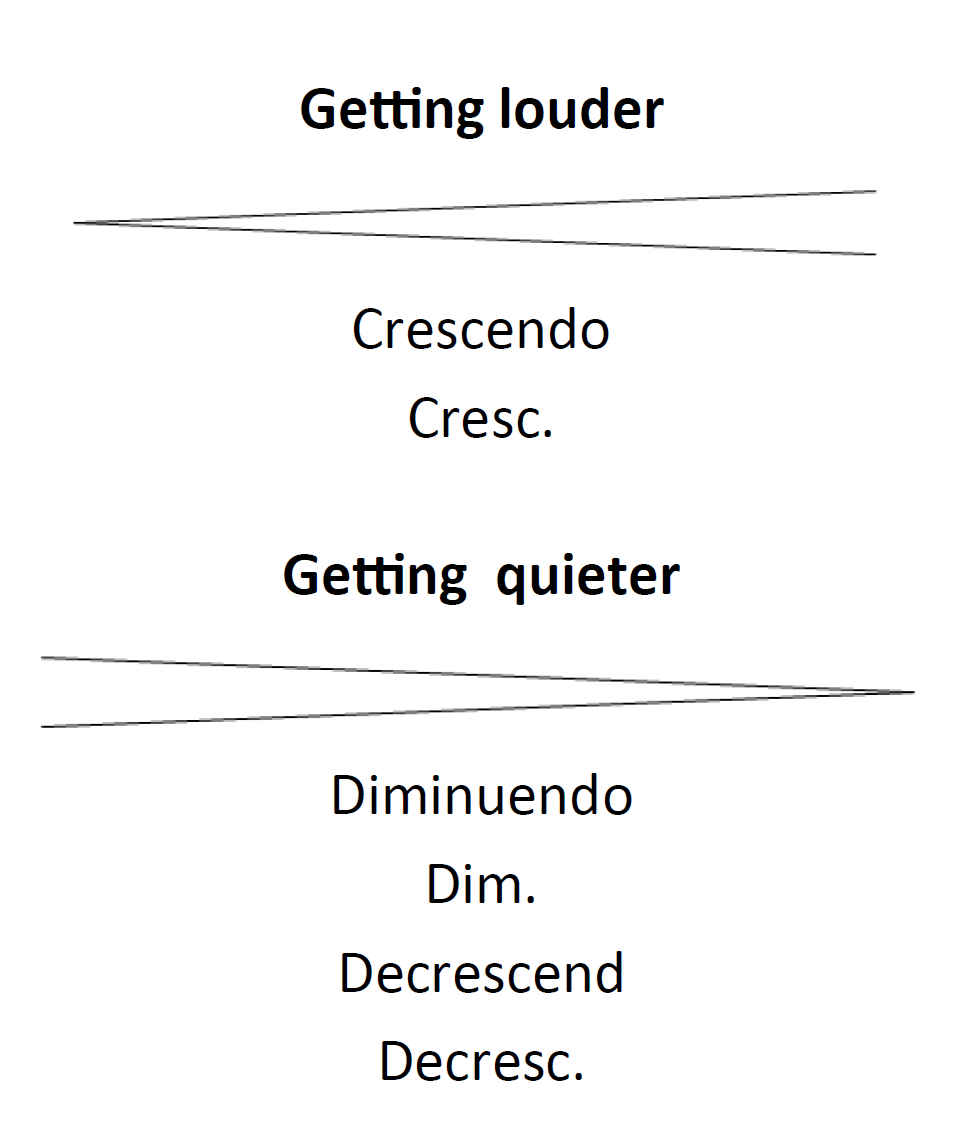
Consonants and Diphthongs
Consonants are placed as late as possible in a note. For instance, if the word CAT is sung on a four beat note, the T comes just before the next note, something like this:
Ca - 2- 3- 4- T
not
Ca - 2- 3- T
Here is a little melody:
 and you can see the Ts placed at the end of each note.
and you can see the Ts placed at the end of each note.
Here is a clip, and you can hear that each T is tucked in just before the next barline, and the final T comes on the double barline.
In this clip, the last note is only sung for 3 complete beats as the T is placed on beat 4.
It's easy to clip a final note short like this if at end of performance lack of concentration takes over.
English is full of compount vowel sounds or DIPHTHONGS.
Say these words loudly and slowly, and you will notice how the vowel sound changes:
Gate, Time
You will get an effect something like this:
G-a-a-a-a-e-e-t
T-a-a-a-a-e-e-m
When singing diphthongs, we save the second vowel sound up until as late as possible. Always at above, never as:
G-a-e-e-e-e-e-t
T-a-e-e-e-e-e-m
Here is a clip with these two words,firstly sung correctly and then incorrectly:
Return to:
TOP
MENU PAGE of Singers Toolkit
MENU PAGE of Organists Online
More on Breathing
We have all been breathing for a long time, so we know how our body feels when the lungs are full/empty.
We use this knowledge to control our breathing and, if we have to sing for a long time without taking a breath, we conserve the air we have and don’t let it all out in the first few seconds.
There is a discipline about breathing and singing which is different from normal speech. Before starting to sing, take a good breath during the beats running up to the start time. For instance:
1, 2, 3, 4, SING
becomes
1, 2, deep breath,
SING.
In the best circumstances, we only breathe where there is a rest or a punctuation mark in the text:
There was a young girl in the choir, (breath) whose
voice arose higher and higher, (breath) ‘til one Sunday night it just vanished ...
In emergencies, you can breathe before a conjunction such as and or but:
... it just vanished from sight (emergency breath) and they found it next day on the spire.
or, if really, really necessary, between words, especially if it's a place where you could imagine a comma being used:
... and the found it (breath) next day (breath) on the spire.
These emergency breaths are little more than a quick pant.
However, never (apart from the examples below) breathe in the middle of a word:
... til one Sun(breath)day night ...
There are many famous examples of mis-breathing.
In this clip, Elvis Presley explains that he, "don't have a wood(breath)en heart":
Occasionally, especially in Classical works, you may have to sing one syllable to many notes, and a mid-word breath becomes really necessary.
The effect of these mid-word breaths is lessened if you:
breathe after a tied or dotted note:
 In this clip, you can hear the little breaks after the tied notes at the signs.
In this clip, you can hear the little breaks after the tied notes at the signs.
It's also possible to breath between repeats of the same musical idea (that is, in a sequence):
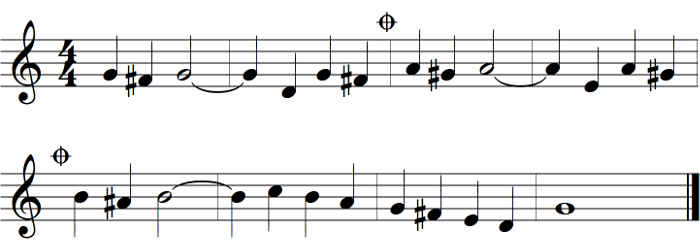 Again, a clip with little breaks at the signs.
Again, a clip with little breaks at the signs.
or just before big leaps:
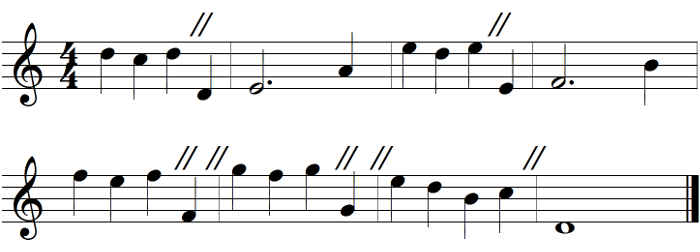
Of course, you can use a combination of these. If you are in a large group all singing the same part, it's not going to matter too much when and which method you use. However,
it's possible that the conductor, sensing your
corporate need, will specify exactly where to take these emergency breaths.
Taking a little break before a large leap can help in placing the next note precisely, avoiding the evils of SCOOPING.
Return to:
TOP
MENU PAGE of Singers Toolkit
MENU PAGE of Organists Online
Scooping
Scooping occurs at the beginning of a piece, after a few bars rest, or between notes with a large leap between them. It's the process of coming
in on a random note and quickly sliding to the correct note - something like this:
Listen to yourself when singing to see if this is occuring. If possible, before starting, try and imagine the note you are going to sing and get your voice ready for that note. It's a bit like a sprinter getting on the starting blocks.
With experience and practice, it gets easier to avoid this.
Return to:
TOP
MENU PAGE of Singers Toolkit
MENU PAGE of Organists Online
Rogue Consonants
Avoid introducing rogue consonants between words starting/ending with vowels. For example, if you are singing Ding Dong Merrily on High,
the chorus says, "hosanna in excelsis," not "hosanna-r-in excelsis."
Similary, if the text is "now, and for evermore," we don't want to sing, "now-r-and for evermore."
In a similar vein, we don't want to attach consonants to the following word. For instance, "On Christmas night all" doesn't want to become, "On Christmas nigh tall," etc.
Return to:
TOP
MENU PAGE of Singers Toolkit
MENU PAGE of Organists Online
Semi Sight Reading
As mentioned elsewhere, unless your are born lucky, or assiduously practise it, sight reading doesn't just happen of its own accord. However, everyone can SEMI SIGHT READ.
Even it you don't know all the names of the notes,
you can see if there is a large or small leap between notes and sing accordingly.
Similarly, you can see if the notes go up or down, and sing accordingly.
Likewise, even if you can't read rhythms accurately, you can see whether the music is fast or slow, and react appropriately.
There's a lot that a singer can do for their own survival in the hurly-burly of choral performance.
Return to:
TOP
MENU PAGE of Singers Toolkit
MENU PAGE of Organists Online